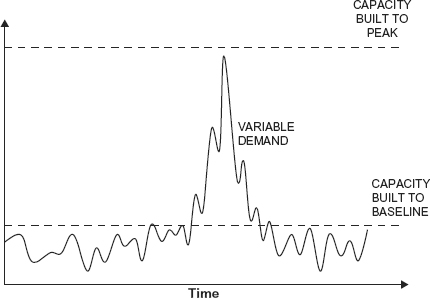CHAPTER 9
Capacity Conundrum
The demand dilemma of variability and unpredictability described in the last chapter leads to the capacity conundrum: unsatisfying options for the amount of fixed capacity to deploy to meet such demand. As shown in Exhibit 9.1, if a company builds capacity to match its peak demand, or higher, it will have substantial excess capacity during off-peak periods. Moreover, peak demand often can be determined only in hindsight; there is no guarantee that the next peak won’t be much larger than any prior peak. This excess capacity represents either nonproductive capital—somewhat akin to stuffing cash under your mattress rather than investing it, only worse, because it is invested in depreciating resources—or unnecessary expense—like paying for a gym membership that you don’t use.
EXHIBIT 9.1 Fixed Capacity Is a Poor Solution to Variable Demand

Conversely, if capacity is sized to the baseline or any other level below peak, there will be insufficient resources to handle spikes. Customers or other users either won’t conclude their transactions, like music fans who won’t be spending money on a sold-out concert, or will be forced to queue, that is, wait in line, negatively impacting the customer experience.
Transactions not served represent demand for the products or services that the business would have monetized: either directly, as in e-commerce, or via third ...
Get Cloudonomics: The Business Value of Cloud Computing, + Website now with the O’Reilly learning platform.
O’Reilly members experience books, live events, courses curated by job role, and more from O’Reilly and nearly 200 top publishers.

